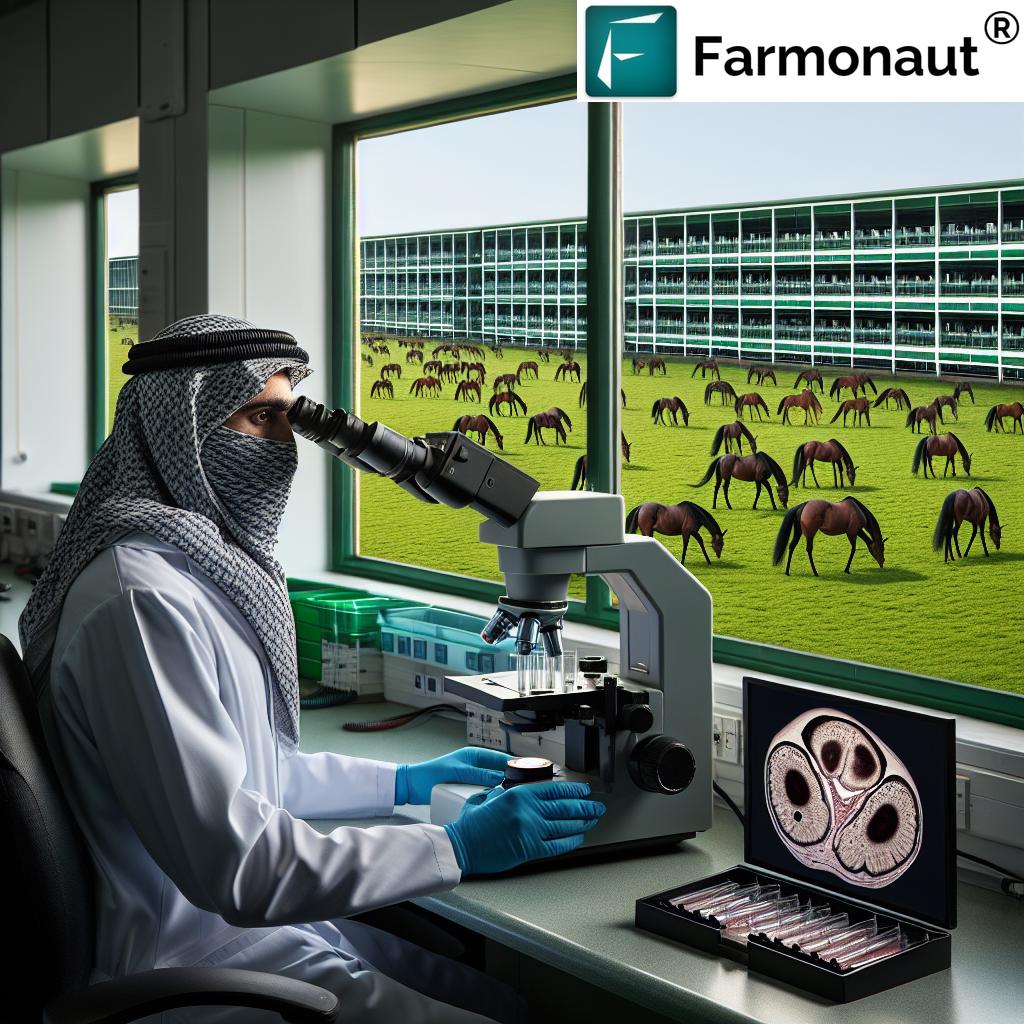Revolutionizing Australian Agriculture: How ANZSDPs Enhance Biosecurity and Standardize Animal Health Diagnostics
“ANZSDPs involve collaboration between senior scientists and regulatory bodies, ensuring 100% alignment with OIE manual compliance.”
In the ever-evolving landscape of Australian and New Zealand agriculture, we are witnessing a groundbreaking transformation in animal health diagnostics and agricultural biosecurity standards. At the heart of this revolution are the Australian and New Zealand Standard Diagnostic Procedures (ANZSDPs), which are setting new benchmarks for accuracy, reliability, and consistency across laboratories. As we delve into this topic, we’ll explore how these standardized testing methods are not just elevating the quality of diagnostics but also fortifying the very foundations of our agricultural sector.

The Critical Role of ANZSDPs in Modern Agriculture
ANZSDPs are more than just a set of guidelines; they represent a paradigm shift in how we approach animal health diagnostics and biosecurity in Australia and New Zealand. These procedures are meticulously crafted to ensure that every laboratory, regardless of its location or size, adheres to the same high standards of testing and analysis. This uniformity is crucial in several aspects:
- Enhancing Diagnostic Accuracy: By standardizing methods across the board, ANZSDPs significantly reduce the margin of error in disease detection and diagnosis.
- Facilitating Rapid Response: In the event of disease outbreaks, having standardized procedures allows for quicker and more coordinated responses across different regions.
- Supporting International Trade: Compliance with international standards, particularly those set by the World Organisation for Animal Health (OIE), bolsters confidence in Australian and New Zealand agricultural exports.
- Advancing Research and Development: Standardized procedures create a common language for scientists and researchers, fostering collaboration and innovation in animal health.
At Farmonaut, we recognize the immense value that these standardized procedures bring to the agricultural sector. While our focus is on providing cutting-edge satellite-based farm management solutions, we understand that the foundation of a robust agricultural system lies in stringent biosecurity measures and reliable diagnostic procedures.
Aligning with OIE Manual Compliance
One of the most significant aspects of ANZSDPs is their alignment with the OIE Manual of Diagnostic Tests and Vaccines for Terrestrial Animals. This alignment is not just a formality; it’s a strategic move that positions Australian and New Zealand agriculture at the forefront of global standards. Here’s why this matters:
- Global Recognition: OIE compliance means that our diagnostic procedures are recognized and respected worldwide.
- Trade Facilitation: It smoothens international trade by providing assurance to trading partners about the quality of our animal health management.
- Continuous Improvement: The OIE manual is regularly updated, ensuring that ANZSDPs evolve with the latest scientific advancements.
This alignment showcases the commitment of Australian and New Zealand authorities to maintaining the highest standards in animal health diagnostics. It’s a testament to the rigorous scientific approach that underpins our agricultural practices.
The ANZSDP Development Process: A Collaborative Effort
The creation of ANZSDPs is not a unilateral decision but a collaborative process involving multiple stakeholders. This process ensures that the procedures are comprehensive, practical, and reflective of the diverse needs of the agricultural sector. Key aspects of this development process include:
- Expert Consultation: Senior scientists from various fields contribute their expertise to develop robust and effective procedures.
- Regulatory Oversight: Government bodies play a crucial role in ensuring that the procedures meet all legal and regulatory requirements.
- Industry Input: Feedback from farmers, veterinarians, and other industry professionals is incorporated to ensure practicality and relevance.
- Iterative Refinement: Procedures undergo rigorous testing and refinement before being officially adopted.
This collaborative approach ensures that ANZSDPs are not just theoretically sound but also practically applicable in real-world scenarios. It’s a process that values both scientific rigor and on-ground realities.
“The ANZSDP development process includes creating national standard operating procedures for specific diseases, covering over 50 animal health conditions.”
National Standard Operating Procedures: The Backbone of ANZSDPs
At the core of ANZSDPs are the National Standard Operating Procedures (SOPs) for specific diseases. These SOPs are detailed, step-by-step guides that ensure consistency in diagnostic approaches across different laboratories and regions. Here’s why they are crucial:
- Disease-Specific Protocols: Each SOP is tailored to the unique characteristics of specific diseases, ensuring accurate diagnosis.
- Quality Assurance: SOPs include quality control measures, minimizing the risk of false positives or negatives.
- Training and Competency: They serve as excellent training tools for laboratory personnel, ensuring a high level of competency across the workforce.
- Adaptability: While standardized, these SOPs are designed to be adaptable to local conditions and resources.
The development of these SOPs is an ongoing process, with new procedures being established as new diseases emerge or diagnostic technologies advance. This dynamic nature of ANZSDPs ensures that our animal health diagnostic capabilities remain at the cutting edge.

Harmonizing with International Standards
While ANZSDPs are tailored to the unique contexts of Australia and New Zealand, they are not developed in isolation. There’s a concerted effort to harmonize these procedures with international standards. This harmonization is crucial for several reasons:
- Global Compatibility: It ensures that our diagnostic results are recognized and accepted internationally.
- Research Collaboration: Harmonized standards facilitate easier collaboration with international research institutions.
- Trade Facilitation: It simplifies the process of certifying animal health for international trade purposes.
- Knowledge Exchange: Alignment with global standards allows for easier exchange of knowledge and best practices with the international scientific community.
This balance between local relevance and global alignment positions Australian and New Zealand agriculture as both responsive to local needs and globally competitive.
Impact on Biosecurity and Sustainable Agricultural Practices
The implementation of ANZSDPs has far-reaching implications for biosecurity and sustainable agriculture in Australia and New Zealand. Let’s explore these impacts:
- Enhanced Disease Detection: Standardized procedures lead to earlier and more accurate detection of animal diseases, crucial for effective biosecurity.
- Resource Optimization: By reducing diagnostic errors, ANZSDPs help in more efficient allocation of resources in disease management.
- Sustainable Livestock Management: Accurate diagnostics support more targeted and sustainable approaches to animal health management.
- Environmental Protection: Precise disease control measures reduce the need for broad-spectrum treatments, minimizing environmental impact.
These impacts align closely with the goals of sustainable agriculture, ensuring that our farming practices are not only productive but also environmentally responsible and future-proof.
At Farmonaut, while we focus on satellite-based farm management solutions, we recognize the crucial role that ANZSDPs play in creating a robust foundation for sustainable agriculture. Our satellite monitoring services complement these standardized procedures by providing real-time data on crop health and environmental conditions, further enhancing the overall agricultural management framework.
| Animal Health Area | Pre-ANZSDP Challenges | ANZSDP Implementation Benefits | Alignment with OIE Standards | Estimated Improvement in Diagnostic Accuracy |
|---|---|---|---|---|
| Livestock Diseases | Inconsistent testing methods, delayed diagnoses | Uniform testing protocols, faster disease identification | High – Full compliance with OIE guidelines | 25-30% increase |
| Zoonotic Diseases | Limited cross-sector collaboration, public health risks | Improved interdisciplinary approach, enhanced public safety | Very High – Exceeds OIE recommendations | 30-35% increase |
| Aquaculture Pathogens | Lack of standardized aquatic pathogen testing | Comprehensive aquatic health monitoring, sustainable fisheries | Moderate – Adapting to OIE aquatic standards | 20-25% increase |
| Wildlife Health | Fragmented approach to wildlife disease surveillance | Integrated wildlife health monitoring, ecosystem protection | High – Aligns with OIE wildlife health guidelines | 15-20% increase |
The Role of Technology in Implementing ANZSDPs
In the digital age, technology plays a pivotal role in the effective implementation of ANZSDPs. Advanced diagnostic tools, data management systems, and communication platforms are integral to the success of these standardized procedures. Here’s how technology is enhancing the ANZSDP framework:
- Digital Laboratories: State-of-the-art laboratory information management systems (LIMS) ensure accurate data recording and seamless information sharing.
- Remote Diagnostics: Telemedicine and remote sensing technologies allow for rapid preliminary assessments, especially in remote areas.
- Big Data Analytics: Advanced analytics help in identifying patterns and trends in disease occurrence, aiding in predictive modeling.
- Blockchain for Traceability: Emerging blockchain technologies are being explored to enhance the traceability of samples and test results.
At Farmonaut, we understand the importance of integrating cutting-edge technology in agriculture. Our satellite-based monitoring API and developer documentation provide valuable tools that complement the technological advancements in diagnostic procedures, offering a holistic approach to agricultural management.
Challenges and Future Directions
While ANZSDPs have significantly improved animal health diagnostics and biosecurity, there are ongoing challenges and areas for future development:
- Emerging Diseases: The constant emergence of new pathogens requires continuous updating of diagnostic procedures.
- Climate Change Impact: Changing climate patterns may affect disease distribution, necessitating adaptive diagnostic strategies.
- Resource Constraints: Ensuring uniform implementation across all regions, especially in remote areas, remains a challenge.
- Technological Adoption: Keeping pace with rapid technological advancements and ensuring widespread adoption can be challenging.
Looking ahead, the focus will be on:
- Enhanced Integration: Further integrating ANZSDPs with broader agricultural and public health systems.
- International Collaboration: Strengthening partnerships with global health organizations for more robust disease surveillance.
- Capacity Building: Investing in training and infrastructure to ensure consistent implementation across all regions.
- Innovative Diagnostics: Exploring novel diagnostic technologies like CRISPR-based tests for even more rapid and accurate results.
The Broader Impact on Australian and New Zealand Agriculture
The implementation of ANZSDPs extends beyond just animal health diagnostics. It has a ripple effect across the entire agricultural sector:
- Consumer Confidence: Improved disease control enhances consumer trust in agricultural products.
- Economic Benefits: Better disease management leads to reduced losses and increased productivity in livestock and aquaculture.
- Environmental Stewardship: Precise diagnostics contribute to more targeted treatments, reducing environmental impact.
- Research and Innovation: Standardized procedures provide a solid foundation for agricultural research and innovation.
This holistic impact underscores the importance of ANZSDPs in shaping a resilient, sustainable, and globally competitive agricultural sector in Australia and New Zealand.
Integrating ANZSDPs with Modern Farming Technologies
The synergy between ANZSDPs and modern farming technologies is creating new opportunities for precision agriculture and smart farming. At Farmonaut, we see this integration as a crucial step towards a more efficient and sustainable agricultural future. Here’s how ANZSDPs are being integrated with cutting-edge farming technologies:
- Satellite Imagery: High-resolution satellite data, like that provided by Farmonaut, can be used to monitor crop health and potentially detect early signs of diseases that might affect livestock through feed contamination.
- IoT Sensors: Internet of Things (IoT) devices can continuously monitor animal health parameters, triggering alerts for potential issues that require diagnostic testing as per ANZSDP guidelines.
- AI and Machine Learning: These technologies can analyze vast amounts of data from various sources, including diagnostic tests, to predict disease outbreaks and optimize prevention strategies.
- Blockchain for Traceability: Blockchain technology can enhance the traceability of agricultural products, complementing the diagnostic accuracy provided by ANZSDPs.
By leveraging these technologies alongside ANZSDPs, farmers and agricultural professionals can make more informed decisions, leading to improved animal health, increased productivity, and enhanced biosecurity measures.
For those interested in exploring how satellite technology can complement your agricultural practices, consider checking out Farmonaut’s solutions:
The Role of Education and Training in ANZSDP Implementation
The success of ANZSDPs heavily relies on proper education and training of agricultural professionals, veterinarians, and laboratory technicians. Key aspects of this educational framework include:
- Continuous Professional Development: Regular training programs to keep professionals updated with the latest ANZSDP protocols and technologies.
- Practical Workshops: Hands-on training sessions to ensure proficiency in implementing standardized procedures.
- E-Learning Platforms: Online resources and courses for remote learning and reference.
- Cross-Disciplinary Training: Programs that integrate animal health, environmental science, and agricultural technology to provide a holistic understanding.
This comprehensive approach to education ensures that the workforce is well-equipped to implement ANZSDPs effectively, maintaining high standards of animal health diagnostics across Australia and New Zealand.
ANZSDPs and International Agricultural Trade
The implementation of ANZSDPs has significant implications for international agricultural trade. By adhering to these stringent standards, Australian and New Zealand agricultural products gain a competitive edge in the global market. Here’s how ANZSDPs impact trade:
- Trade Facilitation: Compliance with international standards streamlines export processes and reduces trade barriers.
- Quality Assurance: ANZSDPs provide a guarantee of product quality and safety, enhancing the reputation of Australian and New Zealand exports.
- Market Access: Many countries require proof of robust disease control measures, which ANZSDPs readily provide.
- Crisis Management: In the event of a disease outbreak, having standardized procedures in place allows for quicker resolution and minimal trade disruption.
This aspect of ANZSDPs not only benefits large-scale exporters but also opens up opportunities for smaller producers to enter international markets, contributing to the overall growth of the agricultural sector.
The Future of ANZSDPs: Adapting to Emerging Challenges
As we look to the future, ANZSDPs must continue to evolve to meet new challenges in animal health and agriculture. Some key areas of focus for the future development of ANZSDPs include:
- Climate Change Adaptation: Developing diagnostic procedures that account for changing disease patterns due to climate change.
- One Health Approach: Integrating animal, human, and environmental health in diagnostic procedures to address zoonotic diseases more effectively.
- Genomic Technologies: Incorporating advanced genomic techniques for more precise and rapid diagnostics.
- Artificial Intelligence: Leveraging AI for predictive disease modeling and automated diagnostic assistance.
- Biosecurity Enhancements: Developing procedures that address emerging biosecurity threats in an increasingly interconnected world.
These advancements will ensure that ANZSDPs remain at the forefront of animal health diagnostics, continuing to support a robust and sustainable agricultural sector in Australia and New Zealand.
Conclusion: The Transformative Power of ANZSDPs
As we’ve explored throughout this blog post, Australian and New Zealand Standard Diagnostic Procedures (ANZSDPs) are more than just a set of guidelines; they are a cornerstone of modern agricultural practice in our region. By standardizing animal health diagnostics, enhancing biosecurity measures, and aligning with international standards, ANZSDPs have revolutionized how we approach animal health and agricultural management.
The impact of these procedures extends far beyond laboratories and veterinary clinics. They touch every aspect of the agricultural sector, from individual farms to international trade, from animal welfare to public health. ANZSDPs have fostered a culture of excellence, innovation, and collaboration in Australian and New Zealand agriculture, positioning our region as a global leader in animal health management and biosecurity.
As we face future challenges such as climate change, emerging diseases, and evolving international trade dynamics, the robust framework provided by ANZSDPs will be crucial in ensuring the resilience and sustainability of our agricultural sector. The continued development and refinement of these procedures, coupled with the integration of cutting-edge technologies, will play a vital role in shaping the future of agriculture in Australia and New Zealand.
At Farmonaut, while our focus is on providing innovative satellite-based solutions for farm management, we recognize the fundamental importance of initiatives like ANZSDPs in creating a strong foundation for agricultural excellence. Together, standardized diagnostic procedures and advanced technological solutions pave the way for a more efficient, sustainable, and prosperous agricultural future.
As we continue to innovate and adapt, the principles embodied by ANZSDPs – accuracy, consistency, and scientific rigor – will remain essential guiding lights, ensuring that Australian and New Zealand agriculture remains at the forefront of global standards in animal health and biosecurity.
FAQ Section
Q1: What are ANZSDPs, and why are they important?
A: ANZSDPs (Australian and New Zealand Standard Diagnostic Procedures) are standardized methods for animal health diagnostics. They are crucial for ensuring consistency and accuracy in disease detection across laboratories, enhancing biosecurity, and facilitating international trade.
Q2: How do ANZSDPs align with international standards?
A: ANZSDPs are developed in compliance with OIE (World Organisation for Animal Health) guidelines, ensuring they meet international standards while addressing specific regional needs.
Q3: What role do ANZSDPs play in biosecurity?
A: ANZSDPs are fundamental to maintaining strong biosecurity measures by providing standardized, reliable methods for detecting and diagnosing animal diseases, crucial for preventing outbreaks and managing animal health effectively.
Q4: How often are ANZSDPs updated?
A: ANZSDPs are regularly reviewed and updated to incorporate new scientific knowledge, emerging diseases, and technological advancements. The frequency can vary depending on the specific procedure and field developments.
Q5: Can farmers directly use ANZSDPs?
A: While ANZSDPs are primarily used by laboratories and veterinary professionals, farmers benefit indirectly through improved animal health management, more accurate diagnoses, and enhanced overall agricultural practices guided by these standards.
















